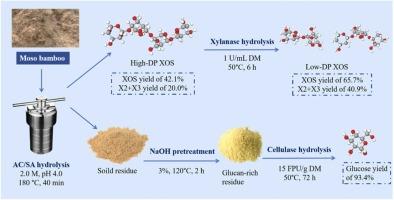木聚糖酶介导的竹醋酸缓冲液水解后低聚木糖聚合度的控制
IF 6.2
1区 农林科学
Q1 AGRICULTURAL ENGINEERING
引用次数: 0
摘要
木质纤维素的有机酸水解制备低聚木糖(XOS)是有效的,但XOS分布的不确定性导致XOS的生物活性较低。以毛竹为原料,采用醋酸/乙酸钠(AC/SA)体系制备XOS,并通过木聚糖酶(XYL)调节XOS的组成和分布。在2.0 M AC/SA, pH 4.0, 180℃,40 min的最佳条件下,XOS收率最高为42.1 %。随后的XYL水解成功地将聚合度(DP)大于6的XOS转化为低DP的XOS,最终的XOS收率达到65.7% %。木二糖和木三糖的总得率达到40.9 %,占总XOS的62.2 %。用氢氧化钠除去固体残渣中的大部分木质素后,通过纤维素水解制得葡萄糖。当纤维素酶负荷为15 FPU/g干物质时,葡萄糖得率为93.4 %。本研究表明,竹材经AC/SA水解后水解XYL可获得较高的XOS产率和较高的生物活性成分。本文章由计算机程序翻译,如有差异,请以英文原文为准。

Xylanase-mediated control of xylooligosaccharide polymerization degree following acetic acid buffer hydrolysis of bamboo
Organic acid hydrolysis from lignocelluloses to produce xylooligosaccharides (XOS) is efficient, but the uncertainty of the distribution of the XOS lead to low bioactivity of XOS. In the present work, XOS was produced from moso bamboo by acetic acid/sodium acetate (AC/SA) system, and the XOS composition and distribution was adjusted by xylanase (XYL). The maximum XOS yield was 42.1 % under the optimal conditions of 2.0 M AC/SA, pH 4.0, 180 °C, 40 min. The subsequent XYL hydrolysis successfully transformed XOS with a degree of polymerization (DP) higher than 6 to low-DP XOS and the final XOS yield reached 65.7 %. The total yield of xylobiose and xylotriose reached a high level of 40.9 %, accounting for 62.2 % of the total XOS. After removing most of lignin from the solid residue with sodium hydroxide, glucose was produced by cellulolytic hydrolysis. When the cellulase load was 15 FPU/g dry matter, the yield of glucose was 93.4 %. This work suggested that XYL hydrolysis after AC/SA hydrolysis of bamboo could achieve a high XOS yield with high bioactivity components from moso bamboo.
求助全文
通过发布文献求助,成功后即可免费获取论文全文。
去求助
来源期刊

Industrial Crops and Products
农林科学-农业工程
CiteScore
9.50
自引率
8.50%
发文量
1518
审稿时长
43 days
期刊介绍:
Industrial Crops and Products is an International Journal publishing academic and industrial research on industrial (defined as non-food/non-feed) crops and products. Papers concern both crop-oriented and bio-based materials from crops-oriented research, and should be of interest to an international audience, hypothesis driven, and where comparisons are made statistics performed.
 求助内容:
求助内容: 应助结果提醒方式:
应助结果提醒方式:


